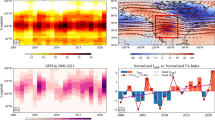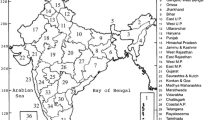Abstract
In this study, the effect of the tropical North Atlantic (TNA) sea surface temperature (SST) variation in inducing the circulation anomaly in the Indo-East Asian monsoon (IEAM) region is investigated through the observational analysis and numerical modeling. The observational analysis shows that the TNA summer SST is positively correlated with the preceding winter Niño3 SST and is simultaneously correlated with the circulation in the IEAM region. The simultaneous circulation pattern resembles that of the ENSO-decaying summer. The positive correlation between the TNA SST and the Niño3 region SST is primarily ascribed to the surface latent heat flux and short wave radiation anomalies induced by the ENSO teleconnection. Coupled general circulation model experiments show that, while including the air-sea coupling in the Atlantic, the model can reproduce the main features of the IEAM circulation, such as an anomalous anticyclone over the western North Pacific (WNP) and southerly anomalies over southeast China. While the climatological Atlantic SST is prescribed, the circulation over the WNP displays a significantly different pattern, with an eastward migration of the WNP anticyclone and the associated northerly anomalies over southeast China. It is argued that anticyclonic shear and Ekman divergence associated with the atmospheric Kelvin wave response to the TNA warm SSTA forcing is the primary mechanism for the generation of the anomalous anticyclone in WNP. The results presented in this study provide a teleconnection pattern between TNA and short-term climate variability in IEAM region.
Similar content being viewed by others
References
Lau N C, Nath M J. A modeling study of the relative roles of tropical and extratropical SST anomalies in the variability of the global atmosphere-ocean system. J Clim, 1994, 7: 1184–1207
Alexander M A, Bladé I, Newman M, et al. The atmospheric bridge: The influence of ENSO teleconnections on air-sea interaction over the global oceans. J Clim, 2002, 15: 2205–2231
Huang R H, Wu Y F. The influence of ENSO on the summer climate change in China and its mechanism. Adv Atmos Sci, 1989, 6: 21–32
Liu Y Q, Ding Y H. Reappraisal of the influence of ENSO events on seasonal precipitation and temperature in China (in Chinese). Sci Atmos Sin, 1995, 19: 200–208
Zhang R, Sumi A, Kimoto M. A diagnostic study of the impact of El Niño on the precipitation in China. Adv Atmos Sci, 1999, 16: 229–241
Zhang R, Sumi A. Moisture circulation over East Asia during El Niño episode in northern winter, spring and autumn. J Meteor Soc Jpn, 2002, 80: 213–227
Zhang R, Sumi A, Kimoto M. Impact of El Niño on the East Asian monsoon: A diagnostic study of the’ 86/87 and’ 91/92 events. J Meteor Soc Jpn, 1996, 74: 49–62
Wang B, Wu R, Fu X. Pacific-East Asia teleconnection: How does ENSO affect East Asian climate? J Clim, 2000, 13: 1517–1536
Wang B, Wu R, Li T. Atmosphere-warm ocean interaction and its impact on Asian-Australian monsoon variability. J Clim, 2003, 16: 1195–1211
Lau N C, Nath M J. Impact of ENSO on the variability of the Asian-Australian monsoons as simulated in GCM experiments. J Clim, 2000, 13: 4287–4309
Yang J L, Liu Q Y, Xie S P, et al. Impact of the Indian Ocean SST basin mode on the Asian summer monsoon. Geophys Res Lett, 2007, 34: L02708, doi:10.1029/2006GL028571
Xie S P, Hu K, Hafner J, et al. Indian Ocean capacitor effect on Indo-Western Pacific climate during the summer following El Niño. J Clim, 2009, 22: 730–747
Lu R, Dong B. Impact of Atlantic sea surface temperature anomalies on the summer climate in the western North Pacific during 1997–1998. J Geophys Res, 2005, 110: D16102, doi:10.1029/2004JD-005676
Kucharski F, Bracco A, Yoo J H, et al. Low-frequency variability of the Indian monsoon-ENSO relationship and the tropical Atlantic: The & ldweakening” of the 1980s and 1990s. J Clim, 2007, 20: 2255–2265
Chen W, Kang L H, Wang D. The coupling relationship between summer rainfall in China and global sea surface temperature (in Chinese). Clim Environ Res, 2006, 11: 259–269
Klein S A, Soden B J, Lau N C. Remote sea surface variations during ENSO: Evidence for a tropical atmospheric bridge. J Clim, 1999, 12: 917–932
Saravanan R, Chang P. Interaction between tropical Atlantic variability and El Niño-Southern Oscillation. J Clim 2000, 13: 2177–2194
Giannini A, Kushnir Y, Cane M A. Interannual variability of Caribbean rainfall, ENSO and the Atlantic Ocean. J Clim, 2000, 13: 297–311
Wang B, Kang I S, Lee J Y. Ensemble simulations of Asian-Australian monsoon variability by 11 AGCMs. J Clim, 2004, 17: 803–818
Wang B, Ding Q H, Fu X H, et al. Fundamental challenge in simulation and prediction of summer monsoon rainfall. Geophys Res Lett, 2005, 32: L15711, doi: 10.1029/2005GL022734
Wu B, Zhou T, Li T. Contrast of rainfall-SST relationships in the western north Pacific between the ENSO-developing and ENSOdecaying summers. J Clim, 2009, 22: 4398–4405
Reynolds R W, Rayner N A, Smith T M, et al. An improved in situ and satellite SST analysis for climate. J Clim, 2002, 15: 1609–1625
Rayner N A, Horton E B, Parker D E, et al. Version 2.2 of the Global sea-ice and Sea Surface Temperature data set, 1903–1994. Clim Res Tech Note 74, 1996
Yu L, Jin X, Weller V. Multidecade Global Flux Datasets from the Objectively Analyzed Air-sea Fluxes (OAFlux) Project: Latent and sensible heat fluxes, ocean evaporation, and related surface meteorological variables. Woods Hole Oceanographic Institution OAFlux Project Technical Report, 2008
Kalnay E, Kanamitsu M, Kistler M. The NCEP/NCAR 40-year reanalysis project. Bull Am Meteorol Soc, 1996, 77: 437–471
Xie P, Arkin P A. Global precipitation: A 17-year monthly analysis based on gauge observations, satellite estimates, and numerical model outputs. Bull Am Meteorol Soc, 1997, 78: 2539–2558
Pacanowski R C. MOM2 Documentation, user’s guide and reference manual. GFDL Ocean Technical Report 3.2., 1996
Roeckner E, Arpe K, Bengtsson L. The atmospheric general circulation model ECHAM-4: Model description and simulation of present-day climate. Max-Planck-Institute for Meteorology Report 218, 1996
Pacanowski R C, Philander G. Parameterization of vertical mixing in numerical models of the tropical ocean. J Phys Oceanogr, 1981, 11: 1442–1451
Large W G, Danasbogulu G, McWilliams J C, et al. Equatorial circulation of a global ocean climate model with anisotropic viscosity. J Phys Oceanogr, 2001, 31: 518–536
Neelin J D, Dukstra H A. Ocean-atmosphere interaction and the tropical climatology. Part I: The dangers of flux correction. J Clim, 1995, 8: 1325–1342
Latif M, Sterl A, Maier-Reimer E, et al. Climate variability in a coupled GCM. Part I: The tropical Pacific. J Clim, 1993, 6: 5–21
Fu X, Wang B, Li T. Impacts of air-sea coupling on the simulation of mean Asian summer monsoon in the ECHAM4 model. J Clim, 2002, 15: 2889–2904
Wu B, Zhou T, Li T. Seasonally evolving dominant interannual variability modes of East Asian Climate. J Clim, 2009, 22: 2992–3005
Author information
Authors and Affiliations
Corresponding author
About this article
Cite this article
Rong, X., Zhang, R. & Li, T. Impacts of Atlantic sea surface temperature anomalies on Indo-East Asian summer monsoon-ENSO relationship. Chin. Sci. Bull. 55, 2458–2468 (2010). https://doi.org/10.1007/s11434-010-3098-3
Received:
Accepted:
Published:
Issue Date:
DOI: https://doi.org/10.1007/s11434-010-3098-3




